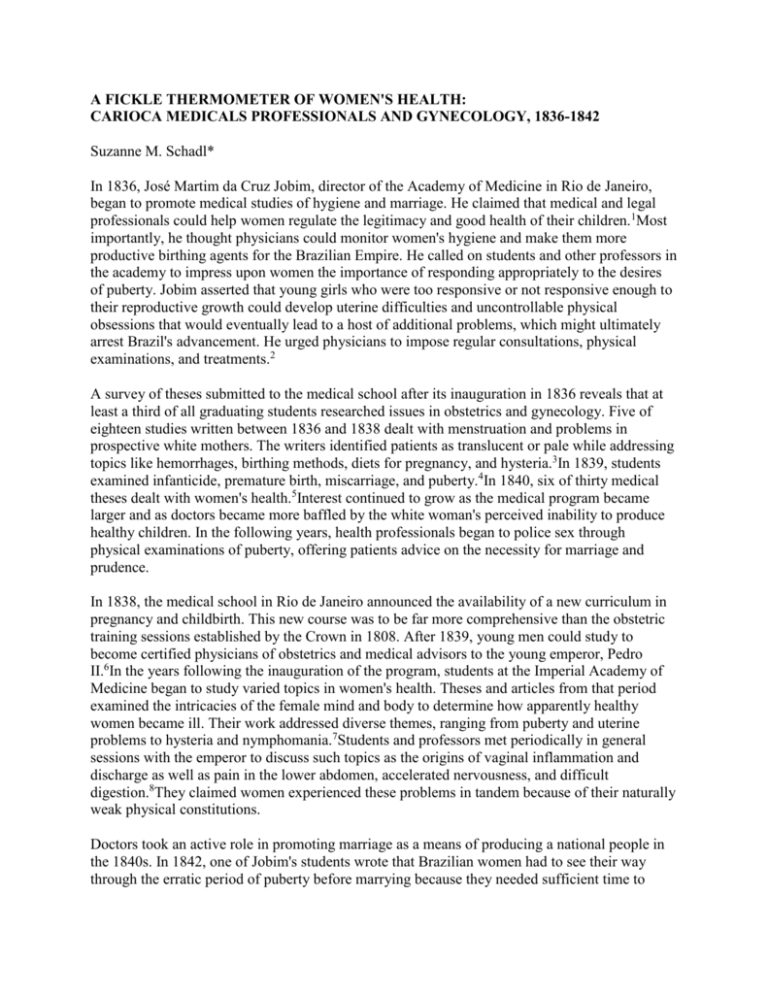A FICKLE THERMOMETER OF WOMEN`S HEALTH: CARIOCA
advertisement

A FICKLE THERMOMETER OF WOMEN'S HEALTH: CARIOCA MEDICALS PROFESSIONALS AND GYNECOLOGY, 1836-1842 Suzanne M. Schadl* In 1836, José Martim da Cruz Jobim, director of the Academy of Medicine in Rio de Janeiro, began to promote medical studies of hygiene and marriage. He claimed that medical and legal professionals could help women regulate the legitimacy and good health of their children.1Most importantly, he thought physicians could monitor women's hygiene and make them more productive birthing agents for the Brazilian Empire. He called on students and other professors in the academy to impress upon women the importance of responding appropriately to the desires of puberty. Jobim asserted that young girls who were too responsive or not responsive enough to their reproductive growth could develop uterine difficulties and uncontrollable physical obsessions that would eventually lead to a host of additional problems, which might ultimately arrest Brazil's advancement. He urged physicians to impose regular consultations, physical examinations, and treatments.2 A survey of theses submitted to the medical school after its inauguration in 1836 reveals that at least a third of all graduating students researched issues in obstetrics and gynecology. Five of eighteen studies written between 1836 and 1838 dealt with menstruation and problems in prospective white mothers. The writers identified patients as translucent or pale while addressing topics like hemorrhages, birthing methods, diets for pregnancy, and hysteria.3In 1839, students examined infanticide, premature birth, miscarriage, and puberty.4In 1840, six of thirty medical theses dealt with women's health.5Interest continued to grow as the medical program became larger and as doctors became more baffled by the white woman's perceived inability to produce healthy children. In the following years, health professionals began to police sex through physical examinations of puberty, offering patients advice on the necessity for marriage and prudence. In 1838, the medical school in Rio de Janeiro announced the availability of a new curriculum in pregnancy and childbirth. This new course was to be far more comprehensive than the obstetric training sessions established by the Crown in 1808. After 1839, young men could study to become certified physicians of obstetrics and medical advisors to the young emperor, Pedro II.6In the years following the inauguration of the program, students at the Imperial Academy of Medicine began to study varied topics in women's health. Theses and articles from that period examined the intricacies of the female mind and body to determine how apparently healthy women became ill. Their work addressed diverse themes, ranging from puberty and uterine problems to hysteria and nymphomania.7Students and professors met periodically in general sessions with the emperor to discuss such topics as the origins of vaginal inflammation and discharge as well as pain in the lower abdomen, accelerated nervousness, and difficult digestion.8They claimed women experienced these problems in tandem because of their naturally weak physical constitutions. Doctors took an active role in promoting marriage as a means of producing a national people in the 1840s. In 1842, one of Jobim's students wrote that Brazilian women had to see their way through the erratic period of puberty before marrying because they needed sufficient time to develop their systems to engage in the “reproductive act.”9This student felt that marriage and reproduction coalesced with the national project that the inability to conceive or deliver a child could give Imperial Brazilian authorities the right to determine when to prohibit or terminate a marriage. He wrote, “I leave it to legislators to decide if the marriage of a woman who has irrevocably lost the characteristic signs of adaptation for the propagation of the species fulfills the law or if it is contrary to the interests of the state.”10As advisors on the health of the empire, young men at the Academy of Medicine influenced the decisions of city officials, grounding their arguments in medical discourse derived from a variety of Western ideas on the problem with women, but not without reference to Brazilian peculiarities. During the Regency and the early imperial period, legislators and doctors expected white cultured women to play an essential role in the process of producing and establishing a Brazilian populace derived from Europe. As women of superior lineage, these administrators felt that white women were the best intermediaries between nature and culture. Black and mixed-race women held the dubious distinction of being closer to nature than their white counterpart and more given to impulse as a result. Like medical and scientific studies in Western Europe and the United States, Brazilian works during this era represented white women as arbitrators between man and nature. The focus on local realities is interesting though. When Brazilian physicians combined the natural reproductive function of woman with the pressures pale women faced in a tropical environment, they uncovered an impossible equation. The heat of the tropics and the cultural practices of Europeans in Rio de Janeiro merged with the apparently weak constitution of white women to provoke uterine and mental illnesses that made it difficult for such women to reproduce effectively. Doctors did not find black and mixed-race women to be free from maladies either, but their problems were different. Using European studies, doctors in Rio de Janeiro argued that black women were naturally prone to accelerated genital growth and sexual depravity. This tendency presumably masculinized black women by enlarging their clitorises to appear and function more like a penis.11Physicians suggested that the excessive physicality of black and mixed-race women enabled their bodies to overcome certain weakness and difficulties, sparing them from contracting ailments such as chlorosis and hysteria. Their strength did not; however, seem to save them from uterine problems and occasional bouts of paranoia. In cases where doctors diagnosed black and mixed-race women with uterine problems, they generally suffered from dysmenorrhea and hemorrhages, thought to be the results of abortion and miscarriage, which doctors generally suggested had been provoked by someone without medical expertise. Nonwhite women were also famed in Brazilian medicine for complicating medical attempts to monitor women and their children on two fronts: first because they utilized midwives and folk remedies, and because they offered their services as wet nurses.12Social expectations of the era did not advocate maternal breastfeeding, since, despite some debate about its health merits, the elite still saw breastfeeding as a job for less fortunate women. It would have been nearly impossible for a privileged woman to loosen her corset and remove multiple layers of fine fabric from her breast to nurse a child. During the 1840s, students in the Academy of Medicine described black and mixed-race wet nurses as carriers of venom and female corruption. One student wrote, “The milk slave women feed our daughters installs the source of corruption in their souls.”13Another suggested, “With milk these unfortunate children drink the venom that poisons their lives.”14White women did not escape blame, either. Physicians believed they could save their children from black and mixedrace wet nurses by listening to medical advice on postnatal hygiene and nutrition. In the 1840s, elite women were increasingly encouraged to monitor their wet nurses carefully, but they were not typically advised themselves to breastfeed, as they were generally thought unfit for such a demanding job. Doctors warned white women to look for signs of infection supposedly written on the bodies of wet nurses. They urged privileged women not to mistake clean, smooth, and shiny black skin as vitality. Physicians argued that sores could remain inconspicuous, relaying the message that female diseases could be both externally graphic and concealed. One practitioner wrote: “There is nothing more deceptive and misleading than all these signs . . . since these conditions are often found in nurses who have suffered from chancres, scrofula and other diseases, which will certainly appear later in children whom they nurse.”15If such diseases went unidentified, there was little for white women to do aside from shouldering the blame for placing their children in harm's way. In rare cases where privileged women did accept the responsibility of feeding their own children despite social norms, physicians implored them to consult professionals on the proper diet and clothing for a nursing mother. The presumed necessity for medical mediation in motherhood and childcare gave physicians an opportunity to monitor women of all races. It also gave them a pretext for expressing masculine intellectual superiority. As interpreters of natural forces in the female body and consultants on reproductive matters, they stood apart from their subjects. In this capacity, physicians expressed their abilities to mend reproductive problems. For them, white upper-class women seemed more liable than women of color to submit to hygienic control because they were already under the private surveillance of men. Perhaps that explains why most obstetric studies between 1836 and 1850 (save those discussing abortion, infanticide, and prostitution) focus solely on white women and methods for teaching them how to acculturate their bodies to the hot humid climate. To the chagrin of physicians in Rio de Janeiro, surveillance seemed to be failing as white women continued to have problems and they seemed to be getting worse. In the mid-1840s, academy members became increasingly fearful that upper- and middle-class white women were acting too freely sexually and mixing secretively with men and women in hotels as clandestine prostitutes. Black women were a different story. Physicians claimed that they were especially wild and much harder to control than white women because they tended not to seek the assistance of doctors.16Many were probably unaware of the resources available to them, and others were likely distrusting of physicians, since a visit to the hospital often paved the way for a trip to the cemetery. One student wrote, “miserable women without resources to treat their illnesses, and not wanting to receive the beneficent hand that the Santa Casa de Misericórdia extends to them, . . . give themselves over to devastating illnesses.”17This presumed failure to seek help in the local charity hospital made it difficult for physicians at the Academy of Medicine to feel as if they could keep an eye on black and racially mixed women even though they tended to spend more time under public scrutiny. The fact that such women were subject to a more conspicuous and independent position in society than most white women placed them outside of the private vigilance of fathers, husbands, and brothers, but often under the gaze of a master, albeit not on a day-to-day basis. Nevertheless, some men felt that the absence of white males in the private lives of such women created an even greater challenge to surveillance. While many women may have preferred midwives and the popular cures of folk medicine, a number of black and mixed-race women did enter the hospital at the Santa Casa de Misericórdia during this period. In 1839, for example, 64 freed women and 53 slaves reached out for the “beneficent hand” of the hospital.18Almost a decade later, 222 freed women and many more slave women went to the Santa Casa de Misericórdia for care.19Their chances for making it out of the hospital alive were not great. During that period 110 freed women died in the hospital. Though available hospital records do not explicitly state the illnesses treated, documentation of the surgeries conducted suggest that most patients suffered from physical difficulties brought on by poor nutrition and/or extensive physical work in the hot sun. Among the problems cited were severely sore or gangrenous legs, arms, and other extremities, as well as cataracts, liver problems, and diverse tumors.20With little reference to reproductive degeneracy in black and mixed-race women, physicians could only tie such women metonymically to ailing children through their roles as wet nurses and domestic servants. Few cases cited in medical discourse actually established direct linkages between wet nurses and children's illness. Unfounded references were commonplace, though. One of the most respected physicians in Rio de Janeiro during much of the imperial period, José Pereira de Rego, argued that diarrhea and fever, common childhood problems, were partly the result of poor mothering and indirectly due to the overcharged sexual appetites of black wet nurses. The worst cases, he claimed, occurred when mother and wet nurses exposed children to syphilis while in the womb or at the breast, which he suggested “was very common to observe in Rio de Janeiro, usually in blacks.”21Other physicians urged elite women to break from the practice of using black slave and servant women to feed their children, advocating white wet nurses or maternal breast-feeding in the spirit of Jean Jacques Rousseau who had suggested in the eighteenth century that a mother who passed her hungry child on to another woman was a bad mother. Not all physicians believed that black wet nurses were bad for children. One professor suggested that black wet nurses were safe because they sought out that type of work to improve themselves.22These mixed ideas extended from medical schools to the general populace and vice versa in pictorial representations that presented black wet nurses as mercenaries, while they labeled breastfeeding white mothers as perverted. Perversion did not, however, define the white woman quite as it did the black woman. The story of one forty-year-old slave washerwoman is illustrative. Based on a perusal of other contemporaneous sources, her medical history did not differ much from other black women. She had successfully given birth to two children, so physicians could see no reason to suspect that her problems were uterine. Her illness seemed a lot like those usually identified in white women who had problems getting pregnant, however. She entered the charity hospital after trying a number of folk remedies that had not relieved the pain she felt in her head and stomach. When the doctor examined her, he found her mouth a little dry and her temperature dangerously above normal. Her skin seemed distended due to dehydration, and external palpitations of her stomach revealed a number of bumps in her uterus. After spending a day in the hospital, her condition worsened and she began to feel pain on the right side of her chest. Despite the fact that she had not coughed in his presence, the doctor felt that she must have been suffering from pleurisy since that was common in poor women. He decided on a regimen of bloodletting and emollients that made matters worse, and after twenty-one days in the hospital, the woman died, not because of pleurisy or uterine illness but because of a mass of hair in her bladder revealed during an autopsy. Her physician suggested that her case was “very rare in the human species”.23There was no speculation about how the ball of hair made its way into the woman's stomach. Nor was there a discussion of her uterine capabilities. He simply described her as an animal and identified her by “perverse “difference. Other references to black women in journals and theses focused on sexual abnormalities, even in cases where the vagina should have been the last concern of physicians. In one case, a black woman with an abscessed gum went to see a physician because the pain in her mouth made it difficult for her to swallow. Despite noting that she was probably suffering from tetanus, the physician proceeded to comment on her sexuality, claiming that she was muscular with a natural facility for sex. He used the opportunity to comment on her condition to reiterate the stereotype of the masculinized and sexually free black woman.24A student comparing the sexual organs of black and white women presented a similar picture but in far more general terms. He cited the scientific studies of the Hottentot Venus and claimed that most writers agreed that black women had highly developed vaginal lips. He tied such developments to the “abuse of coitus” rather than to natural or genetic causes. The student wrote, “Over the lateral parts [of the vagina], one finds the large and small lips or (nymphs), which, according to many authors, are more developed in those women that have abused sex, notwithstanding, this disposition exists naturally in many countries, most of all in Africa among the Hottentot women.”25 During the imperial period, physicians made very clear distinctions between sexuality and reproduction. They suggested quite simply that they were antithetical to one another, supporting a general belief in the existence of two kinds of women: upper class white family women and other women who helped keep white women honest by providing a sexual outlet for men in need. In physicians' eyes, white women who engaged in intercourse for the purpose of reproduction were not sexual. One student tied what he saw as the female desire for family to an innocent preference for friendly companionship over carnal relations. He wrote, “women prefer platonic love while Epicurean pleasures are more attractive to us [men],”26distinguishing reproduction as feminine and sexuality as masculine. Brazilian doctors in the mid-nineteenth century generally viewed sexuality as unfeminine and detrimental to the supreme function of woman since they felt good ladies could desire nothing more than fulfilling their roles as mothers. Doctors urged women to devote themselves to developing their reproductive power and their maternal instincts by embracing domesticity, while they encouraged men to express their virility whenever possible. Women were to embrace their husbands without any modicum of physical pleasure. Doctors warned that spasmodic movement during the act of sex in women could lead to sexual promiscuity. As one physician claimed: “Everything that is capable of causing excitement and erection, and promoting the concentration of forces in the genital organs, could give way to nymphomania.”27Orgasms were out of the question for respectable ladies. The Nervous Womb: Total Body Dysfunction Hysteria was difficult for Brazilian physicians to distinguish from other illnesses since most of them used the term, as did European and North American doctors, as a catchall diagnosis for problems doctors could not otherwise identify. Laryngitis, nausea, heavy coughing, and sneezing, as well as uncontrolled screaming, laughing, and crying were all “symptoms” of hysteria. One student, Antônio Martin Pinheiro, returned to historical descriptions of the illness and defined it in terms similar to those of ancient and classical medical writers. He argued, as they had, that hysteria was particular to women because of the overriding influence of the womb in the female system. In concert with Hippocratic writers, he also suggested that thirst and internal dehydration were central to the onset of the disease, but he noted that it was difficult to see any major form of visible physical modification since the uterus suffered its main effects. Of course, it was unclear how physicians discovered the internal alterations that Pinheiro referred to as organic lesions of the uterus. Though he did not support the outdated hypothesis of the wandering womb, the Brazilian student did reiterate Soranus and suggested that scars on the uterus could adversely affect rational abilities by putting too much pressure on the brain. He argued that the constriction of the throat that appeared commonly in hysterical women proved that uterine swelling could reach far beyond the abdomen. He also felt that hysteria could lead to sexual promiscuity, suggesting that many women felt sexually stimulated by their attacks because of the movement in the uterus. Among the varied cures he found useful were emollients, enclosure, and bed rest.28 In 1838, Rodrigo José Maurício Júnior, one of the first medical students to graduate with a special focus on women's health, submitted a thesis on the causes and effects of hysteria. Using the classical definition of the womb as the center of the female body and mind, Maurício argued that the veins and nerves surrounding the lower abdomen connected the uterus to the central nervous system and the brain. Maurício identified the extreme modification of the reproductive system during puberty as the primary force behind the nervous energy and poor uterine function displayed in hysterical women.29Since virtually all adult women had experienced the changes of puberty, it was difficult to conceive how puberty exacerbated problems in some and not in others. Though Maurício tied a predisposition to hysteria to poor uterine development, he did not dismiss environmental and cultural factors for either problem. He noted that hot and humid climates contributed to excitability and convulsions, suggesting that something as simple as the sunlight or an erotic image in romantic literature could entice women to act on unacceptable desires. Maurício advised that young women with a sanguine temper, pale complexion, and nervous excitability stay away from anything that could excite their imaginations in the early stages of puberty. His list of forbidden fruits included painting, literature, music, alcohol, spicy foods, fragrant emollients, and coffee, as well as the proximity of a desired male.30 Citing two cases he witnessed as a student, Maurício argued that marriage and regular exercise were the most effective treatments for hysteria. He noted that a thirty-year-old widow with a nervous temperament and a sedentary lifestyle began to experience irregular menstrual cycles. She also lost sensibility in her extremities and started to have periodic facial convulsions. At one point, the spasms exaggerated such that she lost control and began to foam at the mouth. Her physician suggested that she marry to satisfy her “natural urge” for love and reproduction. He hoped marriage would cool her system. After giving herself to a husband, the woman's condition reportedly improved. She no longer displayed symptoms of hysteria or menstrual irregularity.31In another case, a young married girl with a delicate constitution and nervous temperament entered a profound state of depression two years after her wedding. She began to experience inexplicable crying fits that irritated her ears and throat as well as the muscles in her abdomen. Her constant sobbing subjected her body to such pressure that she had difficulty breathing because the muscles surrounding her lungs constricted. After a full year of bloodletting and forced menstrual evacuations, special diets, and aromatic infusions, her condition continued to worsen. Symptoms only began to subside when she started walking regularly.32Despite overcoming hysteria, the woman was still sick. Just as her condition began to improve, physicians suspected respiratory swelling. Doctors concluded that her weak constitution and prolonged depression had given way to tuberculosis.33 In many ways, the romantically inscribed version of tuberculosis was a symbol of the elite white woman's struggle in nineteenth-century Rio de Janeiro. Its appearance highlighted the difficult mediation elite ladies faced in patriarchal society, since they were expected to tap into their reproductive urges without falling prey to vanity or sexual desire. Men warned them to avoid sexual activity not tied to the purpose of reproduction. Women who internalized society's view of exclusively reproductive sexuality undoubtedly felt as if they had violated a social pact when they had difficulties conceiving. Paradoxically, men also expected women to stay out of the public eye, just as they encouraged women to exercise in the open air. In addition to these expectations, elite men urged cultured white women to display cultural refinements without absorbing art, literature, or other intellectual pursuits. Some reading was preferable, but excess favored the unhealthy development of intellect over the reproductive system.34This simultaneous repression and expression of sexuality and intellect must have led to conflict within the female mind and body. Social pressures that connected uterine problems with other functions like breathing and thinking must have exacerbated if not caused many women's' problems. The equation for good health in nineteenth-century Brazilian medicine was stacked against women of all races in favor of white men. Those who could control and represent illness as otherness held an extra advantage. With limited access to scientific technology, nineteenthcentury physicians used discursive strategies to diagnose and define their patients. Through rhetoric, developed from experience and observation, male physicians wrote the female body based on its perceived difference from the male body, generally leaving black women out of the analysis. Medical professionals constructed the so-called differences between white men and women in nineteenth-century medicine. More importantly, they determined the standards for health and intervened in women's lives to impose such standards. The male reproductive system was not something that concerned medical professionals at that time since few would concede that it could be subject to diseases other than those passed through sexual relations. Women's health or lack thereof should be understood, thus, as the creation of the men who studied and expressed its importance. Women were restricted from participating in their own medical treatment because men thought it would upset the balance of their system by exercising their brains to the detriment of their reproductive systems. Women who did participate in women's health during this period typically scandalized male physicians. Male doctors at the academy ridiculed one midwife, Madame Durocher, for example, despite her success as the midwife to the royal family and other elite families. She delivered the female babies in the Bragança clan who lived through childhood while men at the medical school had lost the male heirs to the Brazilian throne. A French immigrant in Rio de Janeiro and the wife of a physician, Madame Durocher was taller, stronger, smarter, and more masculine than many thought she should have been. For physicians at the medical school, she was a genetic curiosity herself. She sported a thick black beard that made it difficult to distinguish her as a woman. Had she not favored dresses over trousers and long hair over a shorter style, some men might have mistaken her for a man. Her regular presence in the maternity clinic at the medical school seemed a further indication of her masculinity. The ambiguity of Durocher's appearance and her tie to powerful families enabled her to enter a male sphere, though constantly under scrutiny and ridicule.35She was proof that a woman who used her brain could not really be a woman. Most women did not possess such ambiguous features and they held little hope of entering medical professions. Reproduction and Nation In 1839, João das Chagas e Andrade submitted a thesis that illustrated the relational dichotomy between men and women. He observed that women were smaller than men and their bones and muscles were typically weaker. For that reason, he suggested women could not sustain the force men endured but they could withstand the rigors of pregnancy and childbirth if they cared for themselves properly. That was why, Andrade claimed, women lived lifestyles that were more sedentary. Tying gender roles directly to the shape and function of the body, Andrade reasoned that women's bodies paralleled their function in society: “Flexible bones give the female body a form that is more analogous to her prescribed destiny.”36Judging from women's ability to develop a fetus and feed a newborn child, he claimed that pregnancy and childcare had to be the primary duty of the female body. He identified the vagina, the vulva, the uterus, and the breasts as the most important parts in the female system. The first two organs, he argued, worked in tandem to inspire women to procreate, while the second two enabled them to do so. Andrade suggested that the flexible and soft quality of the female body also enabled the breasts to swell with milk during and directly after pregnancy: “The clavicle bones are less curved to allow more space for the development of the breasts.”37 Andrade read and wrote the female body as a supplier of life. After establishing the importance of the female reproductive organs, he turned his attention to puberty, the period in which he felt women became viable members of society. He argued that understanding the instability of physical changes during puberty would help physicians develop hygienic means to modify the female body and eradicate the illnesses that appeared during its onset. Hygiene, he wrote, “made it possible to correct the deviations of nature.”38Under the watchful eye of physicians, Andrade felt that women could avoid problems like epilepsy, hysteria, and nymphomania. He viewed menstruation as the best thermometer of women's health. If menses did not appear in Brazilian women during their early teenage years, he suggested that this indicated they had some natural or genetic impediment to reproduction. It was equally problematic for menses to appear too soon, since the early onset of puberty generally marked accelerated reproductive development. He noted that white women rarely suffered from the second problem, since their internal systems were thought to be too cold for menses to appear even at the correct time. Andrade felt that moving the ligaments surrounding the womb with periodic exercise could warm the uterus. In cases where a woman's internal organs were especially cold, he claimed that rigorous horse rides and warm baths would be the best treatment. He noted that a daily walk would suffice in cases of more normal temperatures.39 A mediation of internal and external temperatures was not the only challenge Andrade identified for young white women in Brazil. He suggested they had to be better prepared to adjust cultural expectations to their physical abilities. He claimed that women's rational brain mass was smaller than men's. For that reason, he claimed female intellectual capacities were more limited: “From the natural inferiority of the brain, it follows that the collective intellectual capacities of the woman pale in comparison to those of man.”40As a result, he suggested that women would be more likely than men to feel overwhelmed by excessive mental stimulus. Too much intellectual activity, he argued, could inhibit the uterine function by enhancing female sensibilities beyond the necessary inspiration of reproductive urges. Based on pure speculation regarding the development of the female brain, Andrade maintained that women were especially prone to becoming overly sensitive if they read too much or became too interested in music and dance. With no empirical evidence and no real idea of what the female brain looked like, he claimed that the area of the brain responsible for emotions developed more in women than men at puberty. He suggested also that any additional growth could place unbearable pressures on the other bodily functions, making it difficult for women to breathe and eat, let alone fulfill their destinies as mothers.41Andrade was not saying anything that other Western physicians had not already said, but he was applying their hypotheses to the Brazilian context at a crucial juncture. In 1840, professors at the medical school in Rio de Janeiro honored Andrade's thesis as one of the best in the graduating class. They advertised it as a clear and precise examination of the questions surrounding puberty, pregnancy, and childbirth.42José Joaquim Firmino Júnior addressed the same concern in his study of menstruation. Like Andrade, he argued that the existence of young women revolved around their ability to bear and care for children: “The life of woman encompasses a series of experiences that converge in one final goal: the reproduction of the species.” For Firmino, the most salient function of women in society was the desire43and ability to love their families and, by extension, their nation. As a transmitter of human life, Firmino maintained that women were to transcend their mortal beings and offer their hearts and minds for the advancement of men in their society: “A woman no longer lives for herself; she belongs to her species and posterity, and not to the present. She is called to the end for which she is destined—procreation.”44 In the presence of the emperor in December 1841, José Tavares de Mello, another student at the Imperial Academy of Medicine, suggested that puberty was a metaphor for the early stages of national development. He described the period thus: “It is the moment in life where nature, after having given the principal organs of the [masculine and feminine] economy a chance to develop, as they should have, grants members of each sex the respective means through which to meet and propagate the species.”45In addition to linking both male and female bodies to the process of reproducing the species, Mello the development of the female body directly to the climate in which women lived. Girls in Brazil, he argued, developed faster than Europeans did because the tropical climate accelerated maturity in the female body.46He suggested doctors pay extra attention to white women during puberty, maintaining that unexpected rapid physical changes could lead to inappropriate urges. As his professor, José Martim da Cruz Jobim had noted several years earlier, Mello believed that puberty had to be met with temperance and discretion to result in the eventual propagation of a national people. It was not a period to take lightly. Mello argued that nature afforded white women the ability to perpetuate and conserve the species, but it was not an easy task. Among the many barriers they faced were heat and humidity as well as poor hygiene and a naturally weak physical constitution. He was especially concerned that women growing up in increasingly busy and crowded cities like Rio de Janeiro would suffer dangerously accelerated development because of increased mental stimuli. He wrote, “Prolonged cerebral activity does not only limit the brain's capacity to control action and movement, weakening the energy of other organs, it also gives way to susceptibility, occasioned by seizures, nervous disorders, and several other afflictions.”47For that reason, Mello urged wealthy families to prohibit excessive reading for girls and to move into suburban areas where women could escape the hustle and bustle of the street. He argued that the quiet and peaceful setting of gardens and countrysides would allow young girls sufficient time to develop physically without external pressures. The fresh air, he stated, roused menstrual fluids into a slow, steady, and regular motion.48Mello noted that environmental factors could be fatal, however, if not observed while clothed in the proper attire. He advised that women wear wool and silk in the winter and cotton, and linen in the summer to keep their bodies at the right temperature, since he believed that atmospheric pressures could inhibit muscle movement and constrict the menstrual cycle.49 As medical studies of women proliferated in the 1840s, physicians began to take on the roles of architects and designers, counseling their patients on everything from the proper window decor to appropriate clothing. They also advised crown officials on the most effective means to regulate women through hygiene. Physicians became authorities on the tropical climate, common foodstuffs, and fabric. They were so important, as Gilberto Freyre later noted, that they replaced the priest-confessor as the man most privy to the intimate lives of women and their families.50Physicians told people when and where to move. They also counseled families on exercise and the proper materials for the construction of homes. At the behest of physicians, elite families began to move to the suburbs south of Rio de Janeiro. Despite attempts to remove themselves from the city into more quiet neighborhoods, elite women still appeared afflicted by varied sexual perversions and lethargy, as evidenced in the continued attention doctors paid to such problems during the 1840s. Doctors placed white women in an impossible position. Their physical statures, social expectations, and reproductive capabilities did not coincide with success. Discourse surrounding such failures in the 1840s led some intellectuals to question the viability of elite white motherhood in Brazil. Speculation in the Academy of Medicine led physicians to explain that white women could not properly mediate the changes in their bodies and the growth of the city with the pressures of heat and humidity. Simply put, they were not reproducing as expected. Black and mixed-race women, on the other hand, did seem to get pregnant and have children, much to the chagrin of officials who desired the reproduction of white Brazilians. In the 1850s and 1860s, physicians referred to black and mixed-race pregnancies with greater frequency. It seemed that the ideal solution to population and race problems was not attainable, but something had to be done to ensure that Brazil would prosper. _________________________ *Suzanne M. Schadl is an Assistant Professor of History and the Co-Director of Hispanic/Latin American and Caribbean Studies at Roanoke College in Salem, Virginia. 1 José Martim da Cruz Jobim, “Discurso abrindo o seu curso de Medicina Legal na Faculdade de Medicina do Rio de Janeiro, Revista Medica Fluminense 2, no. 1 (Apr. 1836): 20–30. 2 Jobim, “Discurso abrindo,” 20–30. 3 Among the titles of theses in those years were Manoel Moreira de Figueredo e Vasconcelos, “A hemorragia uterina e puerperal” (1836); Antônio José Rodrigues Capistrano, “A metorrágia” (1836); Antônio José da Fonseca Lessa, “Sobre as convulsões puerperães” (1937); Agustino José Ferreira Bretas, “A utilidade do alimento maternal” (1838); Camilo José de Moura, “O hydrocele da túnica vaginal” (1838); and Pedro da Silva, “Os cuidados que a mulher reclama depois do parto” (1838). These titles are indexed in Fernandes, O Conselheiro Jobim and Alfredo Nascimento, O centenário da faculdade de medicina do Rio de Janeiro 1829–1929: Primórdio e evolução da medicina no Brasil (Rio de Janeiro: Imprensa Nacional, 1929). 4 Herculano Augusto Lafance Cunha, S obre a prostituição em particular na cidade do Rio de Janeiro (Rio de Janeiro: Typographia Imparcial de Francisco de Paula Brito, 1845). Other titles making this argument included Antônio José Perreira das Neves, “Infanticídio” (1839); Augusto César Sousa, “O parto prematuro provocado” (1839); and Miguel Ferreira Tavares, “Metorrágia Externa Puerperal” (1939). 5 These included Antônio Gonçalves D'Araújo Leitão, “Hygiene da infância” (1940); Antônio Perreira de Barros, “O abôrto” (1840); Francisco Antônio Nunes, “O trabalho do parto” (1840); Francisco Gonorato de Moura, “O parto impossível” (1840); and Tomas José Xavier dos Passos Pacheco e Costa, “Alimento maternal” (1840). 6 Dr. Nunes Garcia, “Huma memória sua sobre huma nova cadeira para partos,” Notas da Sessão Geral da Academia, August 23, 1838, Archive of the National Academy of Medicine, Rio de Janeiro. 7 For a history of the school and bibliography of select theses, see Alfredo Nascimento, O centenário da faculdade de medicina do Rio de Janeiro 1829–1929: Primórdio e evolução da medicina no Brasil (Rio de Janeiro: Imprensa Nacional, 1929). 8 Medical professionals discussed these problems in “A Sessão Geral” of 1838. Their commentaries are noted in “Notas da Sessão Geral, Mar. 1939, Archive of the National Academy of Medicine. 9 Valle, Mulher e matrimonio, 13: “o acto da reprodução.” 10 Valle, Mulher e matrimonio, 21: “Eu deixo aos legisladores o cuidado de decidir, se o casamento de huma mulher, que tem irrevogavalmente perdido o signal caracteristico de aptidão para a propagação da especie, preenche o fim da lei, e de provar, se he contrario aos interesses do estado.” 11 Gilman,“ Black Bodies, White Bodies; Gilman, Freud, Race, and Gender (Princeton: Princeton Univ. Press, 1993); and Gilman, “Sexology, Psychoanalysis and Degeneration: From a Theory of Race to a Race to Theory,” in Degeneration: The Dark Side of Progress, ed. J. Edward Chamberlain and Sander L. Gilman (New York: Columbia Univ. Press, 1985). 12 Lauderdale-Graham, House and Street . 13 Cunha, Sobre a prostituição em particular na cidade do Rio de Janeiro, 32: “As escravas são amas de nossas filhas que no leite com que as alimentam lhes instilam na alma o germen da corrupção.” 14 Anastásio Symphizonio de Abreu, Da siphilis e dos meios prophaláticos (Rio de Janeiro: Typographia Universal Laemmert, 1845), 16. “São as encarregadas da saúde e futuro de infelizes crianças que com o leite bebem à peçonha que ha de envenenar a vida.” 15 Cited in Robert Conrad, Children of God's Fire: A Documentary History of Black Slavery in Brazil (Princeton: Princeton Univ. Press, 1983), 56. 16 When black women were mentioned in medical studies of this period it was usually in the context of prostitution and contagious disease. In references to prostitution and syphilis, doctors noted that black women were given to ravenous urges akin to wild animals. They also complained that slave and servant women did not take advantage of the charity services offered them. See Cunha, Sobre a prostituição em particular na cidade do Rio de Janeiro, and Abreu Da siphilis e dos meios prophaláticos, 13. 17 Cunha, Sobre a prostituição em particular na cidade do Rio de Janeiro, 19: “As desgraçadas não tendo recursos para tratarem suas enfermidades e não querendo tão pouco receber a mão beneficente que lhes estende a Santa Casa de Misericórdia . . . anezam-se ao mal que as devora.” 18 Santa Casa de Misericórdia, Série Saúde, National Archive (IS3-3) Movimento do Hospital Santa Casa de Misericórdia, 1839. 19 Santa Casa de Misericórdia, Série Saúde, National Archive (IS3-5) Movimento do Hospital Santa Casa de Misericórdia, 1848. 20 Santa Casa de Misericórdia, Série Saúde, National Archive (IS3-5) Relatório do Hospital Santa Casa de Misericórdia, 1854–1859. 21 José Pereira de Rego, “Considerações sobre algumas moléstias de crianças mais frequentes no Rio de Janeiro,” Revista de Medicina Brasiliense 4, no. 7 (1849): 159. É ainda mais grave nas crianças que padecem de outros incommodos, quer no ventre, quer no peito, mormente quando a estes incommodos se ajunta uma disposição hereditária syphilitica ou de outra especie, como é tão commum observar-se no Rio de Janeiro, sobretudo nos crioulos.” 22 Dr. Ferreira Pinto cited in Luiz Felipe de Alencastro, “Vida privada e ordem privada no Império,” in História da vida privada no Brasil: Império: A corte e a modernidade nacional (São Paulo: Companhia das Letras, 1997), 11–94. 23 Francisco Pereira Sebrão de Almeida, “Observação de huma febre intermitente perniciosa, sendo os últimos accessos acompanhados de huma intensa cystite a qual era determinada pela existencia de huma grande quantidade de cabellos na bexiga,” Revista Médica Fluminense 4, no. 5 (1939): 133–63, “bastante raro na especie humana.” 24 João Evangelista Rangel, “O tétano conhecido debaixo do nome de opisthotonus,” Revista Médica Fluminense 8, no. 2 (1839): 337–58. 25 José Rodrigues Gonsalves Valle, Mulher e matrimónio medicamente considerados (Rio de Janeiro: Typographia de M.A. da Silva Lima, 1847), 7. “Sobre as partes lateraes achão-se grandes e pequenos lábios ou nymphas, as quaes, segundo muitos autores, são mais desenvolvidas naquellas mulheres que tem abusado cóito, não obstante, esta disposição existe naturalmente em muitos paizes, sobretudo na Africa entre as mulheres dos Hottentotes.” 26 Valle, Mulher e matrimónio, 13: “ellas preferem o amôr platonico, e que os gostos de Epicuro tem mais attractivos para nós.” 27 Alexandre de Araújo Ribeiro, A nymphomania (Rio de Janeiro: Typographia Franceza, 1842), 11: “tudo emfim que he capaz de determinar o excitamento e erectismo, e promover huma concentração de forças para os orgãos genitaes, pode dar lugar à nymphomania.” 28 Antônio Martins Pinheiro, A histheria (Rio de Janeiro: Typographia Imperial e Constitutional de J. Villeneuve e Comp, 1948). 29 Rodrigo José Maurício Júnior, A hysteria (Rio de Janeiro: Typographia Imparcial F.P. de Brito, 1838), 14. 30 Maurício, A hysteria , 6. 31 Maurício, A hysteria , 10. 32 Maurício, A hysteria ,13. 33 Maurício, A hysteria , 23. 34 Medical references during the early empire listed intellectual pursuits among the primary threats to the female reproductive system. See, for example, Anastásio Symphizonio Abreu, Da siphilis e dos meios prophaláticos (1845); Herculano Augusto Lafance Cunha, Sobre a Prostituição (1845); José Joaquim Ferreira Monteiro de Barros, Considerações geraes sobre a mulher (1845); and Maurício, A hysteria (1838). 35 I have drawn this information from a combination of museum exhibits in the National Academy of Medicine and later debates in medical journals between Madame Durocher and other physicians on the quality of midwifery and gynecology. Those debates are best exemplified in a series of articles collectively gathered under the title “Deve ou não haver parteiras,” Annaes Brasilienses de Medicina 23 (1870–72). 36 Andrade, Sobre a puberdade da mulher, 2: “Os ossos variados dão ao corpo da mulher uma conformação diferente, mais análoga aos destinos que lhe são prescriptos.” 37 Andrade, Sobre a puberdade da mulher, 2: “As clavículas são menos curvas para fornecerem hum maior espaço ao desenvolvimento dos seios.” 38 Andrade, Sobre a puberdade da mulher, 22: “Por hygiene, possão corregir desvios da natureza.” 39 Andrade, Sobre a puberdade da mulher, 26. 40 Andrade, Sobre a puberdade da mulher, 4: “Desta inferioridade do cérebro decorre naturalmente que a energia das faculdades intellectuais da mulher será menor do homem.” 41 Andrade, Sobre a puberdade da mulher . 42 “Advisos,” Revista Médica Fluminense 6, no. 2 (May 1840): 92–95. 43 José Joaquim Firmino Júnior, Sobre a menstruação (Rio de Janeiro: Rio de Janeiro: Typographia Universal de Laemmert, 1845), 6. 44 Firmino, Sobre a menstruação, 7: “A mulher não vive mais para si, ella he da sua espécie e da posteridade, e não do presente. He chamada para o fim que foi lhe destinada—a procriação.” 45 José Tavares de Mello, Considerações sobre a hygiene da mulher durante a puberdade, e apparecimento periódico do fluxo catamenial (Rio de Janeiro: Typographia Universal de Laemmert, 1841),10: “A puberdade . . . é o momento da vida, onde a natureza depois de ter aos principaes orgãos da economia a maior parte do desenvolvimento, que devem ter, concede ao indivíduo de cada sexo os meios respectivos, pelos quaes ele deve concorrer para a propagação da sua espécie.” 46 Mello, Considerações sobre a hygiene, 11. 47 Mello, Considerações sobre a hygiene, 15: “A excitação prolongada do cérebro não se limita só a fazer delle o centro exclusivo d'acções e movimentos, enfraquecendo a energia dos outros orgãos, mas a força tambem tornar-se d'uma suseptibilidade, ocassionada de scephalagiasm, doenças nervosas e outra muitas affecões.” 48 Mello, Considerações sobre a hygiene , 13. 49 Mello, Considerações sobre a hygiene, 14. 50 See Gilberto Freyre, The Mansions and Shanties: The Making of Modern Brazil, trans. Harriet de Onis (New York: Knopf, 1963). Michel Foucault makes a similar argument in The History of Sexuality, Volume I .








